The Range Rover nameplate has evolved over recent years to spawn a whole slew of models under its own brand, but this is the big one – meet the latest iteration of the Range Rover, codenamed L460 for its fifth generation and which comes nine years after the premiere of its predecessor, the L405.
Built on the new Modular Longitudinal Architecture-Flex (MLA-Flex) platform allows for the deployment of internal combustion, plug-in hybrid and from 2024, fully electric powertrain options, along with an integrated network of technologies.
The backbone of the new Range Rover itself, so to speak, offers up to 50% greater torsional rigidity than before with a static rigidity of 30,000 Nm per degree, even with the specification of a full-length panoramic roof.
The steel front bulkhead employs a closed-section arrangement to provide a double-glazing effect, offering a 24% lower transmission of noise and low-frequency vibrations from road surfaces into the cabin – before taking into account other, new refinement-enhancing technologies, says Land Rover. Two lengths of Range Rover are offered from the off, aptly named Standard Wheelbase and Long Wheelbase.
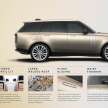
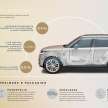
Common across the two are their height (1,870 mm) and their width (2,209 mm including mirrors); the Standard Wheelbase model measures 5,052 mm long while the Long Wheelbase adds 200 mm to reach 5,252 mm, which is entirely to the gain of its wheelbase – 2,997 mm of the SWB plays 3,197 mm of the LWB.
Naturally, the longer vehicle needs more room to make an about-turn; where the standard-wheelbase car has a turning circle of 10.95 m, the more chauffeur-oriented one does it in 11.54 m.
Vital statistics, where a Land Rover product is concerned: the standard-wheelbase model has 295 mm of maximum ground clearance while the LWB has just nominally less at 294 mm; approach and departure angles for both are identical at 34.7 degrees and 29.0 degrees respectively, while breakover is 27.7 degrees for the short-wheelbase (25.2 degrees for the LWB).
Wading depth and maximum incline are identical at 900 mm and 45 degrees (also known as a 100% gradient). In terms of external payload, the L460 Range Rover has a maximum towing capacity of 3,500 kg, and a maximum roof load rating of 100 kg.

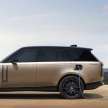
The powertrain range for the L460 Range Rover starts with five specifications – two tunes of straight-six 3.0L petrols, the 360 PS/500 Nm P360 and the 400 PS/550 Nm P400, and two tunes of inline-six 3.0L diesels; the D250 (249 PS/600 Nm), D300 (300 PS/650 Nm) and D350 (350 PS/700 Nm). Topping the lot is the P530 variant, packing a BMW-sourced 4.4 litre turbocharged V8 with 530 PS and 750 Nm.
There are also two plug-in hybrid powertrains offered on the L460 Range Rover, designated the P440e and the P510e. Both featuring a 3.0 litre inline-six cylinder petrol as its internal combustion base, producing peak outputs of 440 PS and 510 PS in total system output, as the model names suggest, and these come from a 105 kW (142 PS) electric motor fed by a 38.2 kWh underfloor battery.
These offer up to 100 km of purely electric running, and Land Rover says three-quarters of daily journeys can be done in this pure EV mode. DC rapid charging can replenish the electric drive motor’s battery to 80% in less than one hour, while AC home charging at 7.2 kW achieves a full, 0-100% charge in five hours. These powertrains represent the L460’s emissions-free running until the pure EV version debuts in 2024.
For its chassis, the L460 Range Rover sports air suspension at all four corners; its front end employs an unequal-length double wishbones while the rear axle uses a five-link configuration. Data is read from the navigation system to prime the suspension on the approach to bends, while the air spring chambers work with twin-valve dampers that react within five milliseconds.
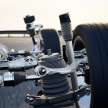

The air suspension system links to the adaptive cruise control system to control body pitch due to changes in speed, while Active Speed Lowering detects when the vehicle is travelling on high-speed roads, lowering its ride height to improve efficiency and control.
Wheels now measure up to 23 inches in diameter on the L460, with wheel/tyre combinations up to 815 mm in diameter also catered for; these are flow-formed and give no more unsprung mass than the previous car’s 22-inch designs, says Land Rover.
The Integrated Chassis Control setup for the L460 Range Rover is made possible by the 48-volt electrical architecture, offering Dynamic Response Pro with active roll control that generates 1,400 Nm of torque, of which 900 Nm is available within 200 milliseconds.
The L460 is also the first Range Rover to come with rear-wheel steering across the board. Up to 7.3 degrees of rear-wheel steering angle is offered; this goes opposite to the front wheels at low speeds for agility, and in-phase with the fronts above 50 km/h for stability.
Inside, infotainment systems are supported by the latest iteration of the manufacturer’s Electrical Vehicle Architecture 2.0 (EVA 2.0). The Pivi Pro infotainment system here in the L460 is presented on a 13.1-inch curved, floating glass touchscreen with haptic feedback, while driver instrumentation comes from a 13.7-inch Interactive Driver Display with configurable, high-definition graphics.
Vision is aided by the 3D surround camera system, including ClearSight Interior Rear View which projects an image from a high-mounted rear-view camera to the interior mirror, making the rear pillars and any obstructing objects “invisible” to eliminate blindspots. Meanwhile for the forward view, ClearSight Ground View projects a view ahead of the vehicle to the central touchscreen, effectively letting the driver “see through” the bonnet to the ground below.
Several configurations of audio continue to be offered in this L460 iteration of the Range Rover, now headlined by a 35-speaker, 1,600-watt Meridian Signature sound system. These include a pair of 60 mm speakers in each of the four main occupants’ headrests, which offer noise-cancelling functions. For firmware updates, the L460 packs more than 70 modules that can receive OTA updates.
Voice control for the L460’s infotainment comes courtesy of Amazon Alexa, enabling the control of music, navigation, phone contact and more through hands-free operation. Alexa also works with the onboard wireless Apple CarPlay and wireless Android Auto connectivity, as well as Baidu Carlife, while wireless device charging is also included here.
For second-row passengers, an available rear seat entertainment system brings a pair of 11.4-inch touchscreens mounted behind the front seatbacks. Every occupant gets a charging socket from each seat, with up to eight USB-C sockets available. The second row gets integrated 60-watt USB-C connections that can charge a laptop without the need for a power pack, says Land Rover; its Wi-Fi hotspot can connect up to eight devices at once.
In keeping with the requisite precautions of these times, the L460 Range Rover features Cabin Air Purification Pro which features dual-nanoe X technology to remove pathogens and reduce allergens in the air to “significantly reduce” viruses and bacteria including SARS-CoV-2 viruses, says Land Rover. 30-minute usage of Cabin Purification Pro is claimed to be 97% effective in eliminating viruses, bacteria and pollutants.
The system includes CO2 management as well as PM2.5 cabin air filtration, both features working in tandem with the cabin temperature controller to balance cleaning of the air with keeping occupants comfortable.
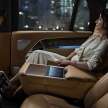

Three seating configurations are offered in the L460-generation Range Rover – the four- and five-seat layouts are available in both standard- and long-wheelbase bodies, the latter exclusively getting the seven-seat layout. These rear seats are heated and cooled with powered adjustment, and can be reclined by up to 12 degrees.
For the seven-seater, the third-row is in a stadium-seating position that places it 41 mm higher than the front seats for improved visibility. When the third row is not in use, the second row can slide back to free up another 50 mm of legroom. Meanwhile, 30-colour ambient lighting features along the doors, footwells and instrumentation and third-row armrests, while the seatbelt buckles too are lit.
In terms of luggage capacity, the L460 Range Rover can take up to 1,841 litres in the SWB loaded to the roofline with rear seats folded (2,601 litres in the LWB), 818 litres to the roofline with the second-row seats in place (1,061 litres), or 725 litres loaded to the waistline (725 litres in the LWB).
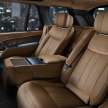
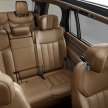
Upholstery in the L460 Range Rover now can offer a Kvadrat wool blend fabric, which Land Rover says is a soft-feeling polyurethane material that feels like leather to the touch but is 30% lighter, and generates 25% of CO2 produced compared to the making of comparable leather upholstery.
Genuine leather remains available for selection on the L460, which in addition to semi-aniline leather, now features near-aniline leather as options; the new, latter choice is softer, gets fewer treatments and less artificial pigmentation. These have the finish and tactility of furniture-grade leather, manufactured with advanced techniques to save over 42 kg of CO2 equivalents per vehicle, says Land Rover.
For driver assistance, the L460 Range Rover brings the latest iteration of Park Assist. This is augmented by Remote Park Assist, which enables the new model to be automatically manoeuvred into and out of perpendicular as well as parallel parking spaces. This employs 12 ultrasonic sensors and four surround view cameras to locate a suitable space, and displays the its findings for the driver to make the selection.
The Driver Assist pack includes adaptive cruise control with steering assist, Driver Condition Response, Blind Spot Assist and Rear Traffic Monitor as standard.
Meanwhile, the Rear Collision Monitor with Occupant Protection Assist employs front and rear corner radars to detect risk of collision up to 70 metres away to prevent or mitigate the effects of a rear-end collision. Hazard lights are activated if a risk of collision is detected, and if collison is deemed to occur, the vehicle is primed for impact by closing the windows, tensioning seatbelts, moving headrests and adjusting the seats’ inclines.
For exterior paints, the standard palette for the L460 Range Rover features a choice of 12 colours in solid, metallic and premium finishes, with the new shades among them Lantau Bronze, Belgravia Green, Batumi Gold and Charente Grey. A further 14 colours can be specified from the SV Bespoke Premium Palette selection, or for a limitless range, the SV Bespoke Match-to-Sample service can be approached.
In its home market of the United Kingdom, the new, fifth-generation Range Rover is available to order, with prices starting from 94,400 pounds sterling (RM539,651).
The post 2022 Range Rover debuts – fifth-generation flagship brings seven-seat layout; pure EV version in 2024 appeared first on Paul Tan's Automotive News.

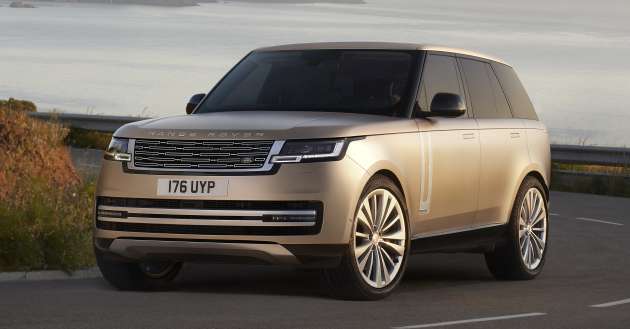
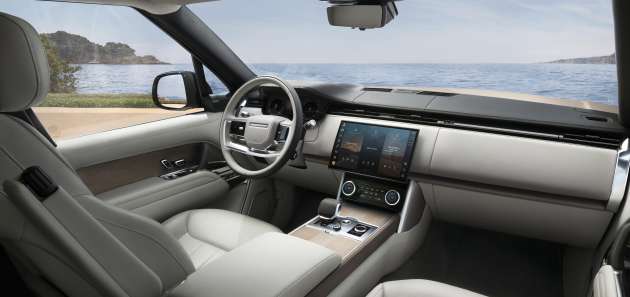

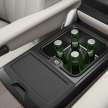

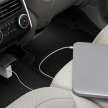
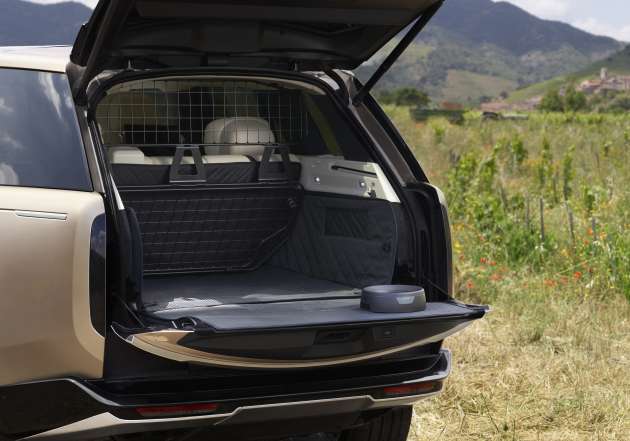
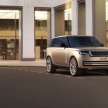
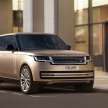
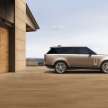

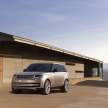
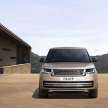
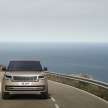
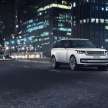

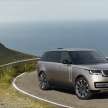
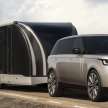
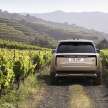
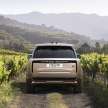
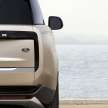
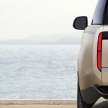
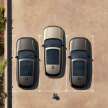
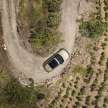
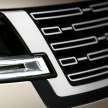
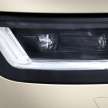
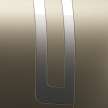
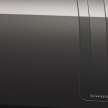
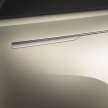
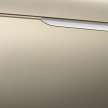
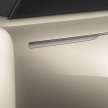
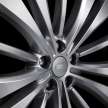
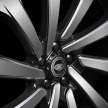
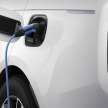
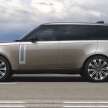

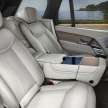
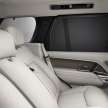
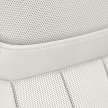
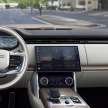
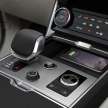

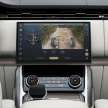
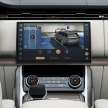
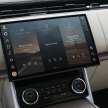
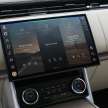
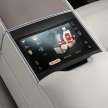
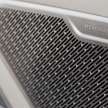
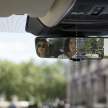
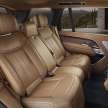
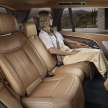
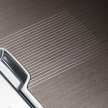
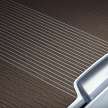

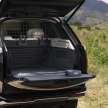
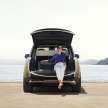
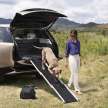
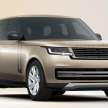
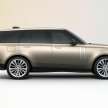
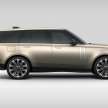
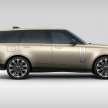
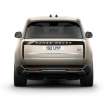
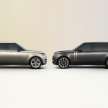
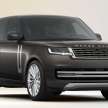

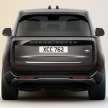
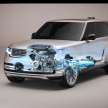
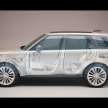

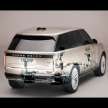

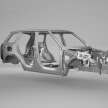
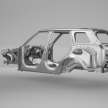
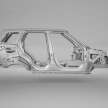
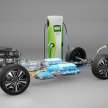
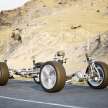

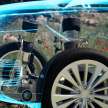
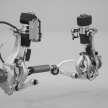
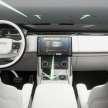
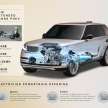
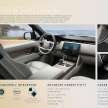

0 Comments